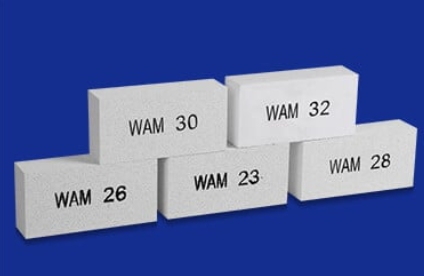The Best Solution For Energy Saving And Reducing CO2 Emission
The Best Solution For Energy Saving And Reducing CO2 Emission
 Tel: +86-532-85717690/85717352/85832089
Tel: +86-532-85717690/85717352/85832089 E-mail: wam@wamcn.net
E-mail: wam@wamcn.net
Insulating firebrick offers resource efficiency, temperature regulation, and improved product homogeneity for high thermal industries like heat treating, ceramic & glassware, and metal processing.
Lightweight insulating firebrick increases furnace lining efficiency because it enables thermal furnaces and kilns to heat up rapidly whilst also maintaining a significant temperature difference outside the equipment.
The Steel/Aluminum industry makes use of the insulating fire brick in their thermal facilities to manage internal temperatures and keep additional energy costs in check.
Clay, kaolin, kyanite, mullite, chamotte, sillimanite, and andalusite are typical raw materials used to produce industrial fire bricks.
These materials, in addition to the required permeability, and average pore diameter of the brick have an impact on its thermal conductivity.
Burnout materials and water are used to create pores in the brick. Wood dust, hay, styrene, and viscose are widely used burnout materials. Furthermore, to improve porosity, a foaming agent may also be applied.
Though metals or carbide granules are utilized as foaming agents in the manufacturing stages, saponins are applied to create foams. In this manner, insulating fire bricks with a porous structure are achieved.
Different manufacturers produce insulating fire bricks through various processes such as slinging, dry pressing, casting, and extrusion.
These various approaches can produce a wide range of features and insulating qualities in the bricks.
This sequential procedure involves hurling the raw materials made into sizable molds onto a conveyor belt.
A moist clay mixture with substantial concentrations of burnout additives is extruded under reduced pressure using the slinger, the semi-extruded materials are slung over a continuously moving board to create more porosity. Afterward, the moist bricks formed are then cured and blazed.
This method can be used to create medium-density insulating fire bricks

Bricks are directly cast during the casting process into sizable plaster molds, usually with the addition of vibratory devices to help improve flowability.
Water-binding minerals such as cement or gypsum are added to the slurry mixture to facilitate the extraction of water and the setting of the mold.
The casted bricks can take quite some time to dry because of their high moisture content.
This technique is used for producing insulating bricks of bigger or perhaps intricate shapes with low to moderate volumes. casting is utilized.
A moist clay mixture with burnout admixtures is forced through an extrusion nozzle during this process. The discharged extrudate is then trimmed into bricks, cured, and blazed.
Typically, dry pressing is usually done uniaxially. High-density industrial fire bricks are usually manufactured using the pressing process since it is subjected to high pressure.
1. Low heat transfer coefficient
2. Reduced permeability
3. High mechanical strength
4. Increased porosity
5. Low weight
6. High resistance to corrosion
Designing and producing high-quality insulating fire bricks is one of our flagship brands. Our products are incredibly strong, dependable, and effective.
Please contact us if you need strong, long-lasting insulating fire bricks to enhance the thermal stability of your furnace.